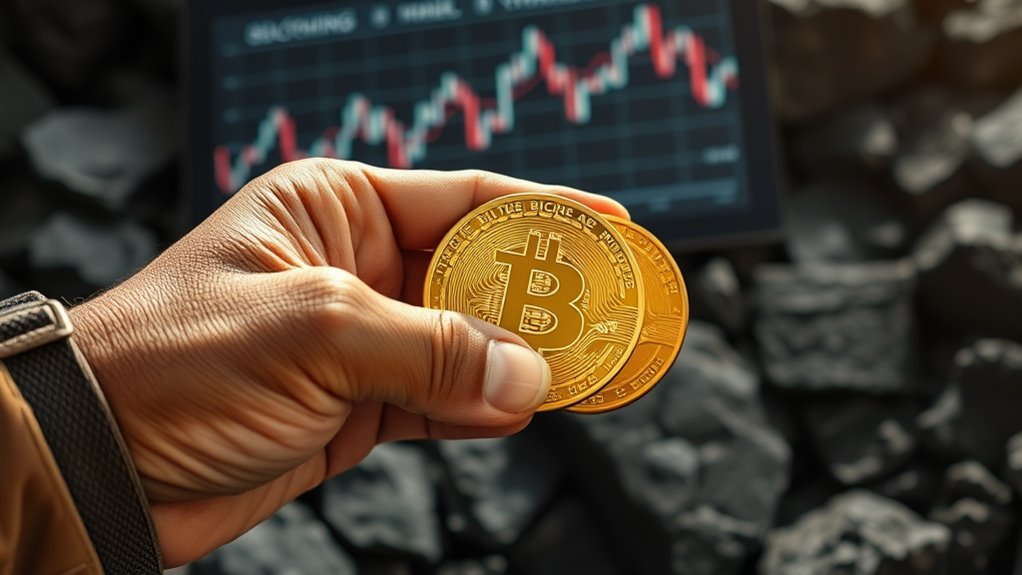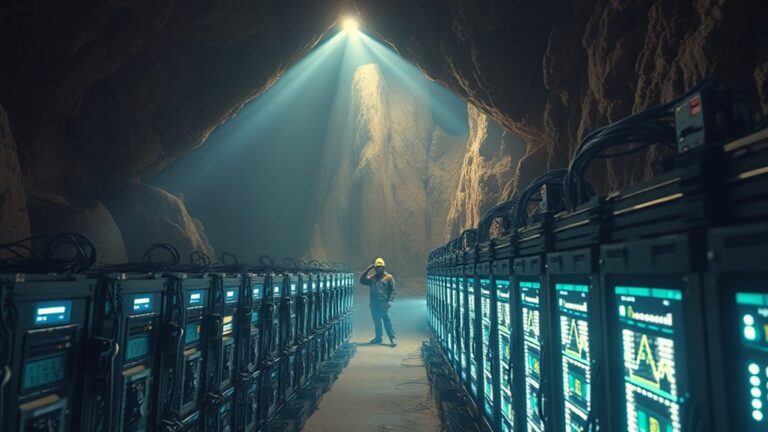
Mining Rewards and Halvings: How Halvings Impact Blockchain Profitability
Bitcoin halvings reduce the block reward miners receive, impacting blockchain profitability by decreasing the supply of new Bitcoin. This reduction can lead to increased mining costs if Bitcoin prices do not rise proportionately. Miners adjust by adopting more energy-efficient equipment, diversifying revenue streams, and joining mining pools to stabilize income. These adaptations are essential for maintaining profitability amidst fluctuating market dynamics and transaction fee importance post-halving. Further exploration reveals more on this evolving topic.
Key Takeaways
- Bitcoin halvings reduce block rewards by 50%, influencing miner profitability and necessitating price increases to offset higher operational costs.
- Miners are adopting energy-efficient technologies and diversifying revenue streams to adapt to reduced rewards and maintain profitability post-halving.
- The transition from CPU/GPU to ASIC hardware centralizes mining power, enhancing efficiency but increasing competition among miners.
- Transaction fees become increasingly vital for miner earnings as block rewards decline, affecting overall blockchain profitability and network dynamics.
- Sustainable mining practices and technological advancements are essential for long-term network security and profitability in a post-halving environment.
Understanding Bitcoin Halvings

Understanding Bitcoin halvings is vital for grasping how the cryptocurrency market operates. Halvings occur approximately every four years, specifically after 210,000 blocks are mined.
This automatic process, embedded in Bitcoin’s protocol by its creator, Satoshi Nakamoto, reduces the block reward, which is the incentive miners receive for validating transactions. The initial reward of 50 Bitcoins was halved to 25 in 2012, continuing to decrease, with the current reward at 3.125 BTC as of April 2024.
The purpose of this mechanism is to regulate the creation of new Bitcoins, enhancing their scarcity, which can potentially increase their value over time. Additionally, understanding the impact of mining difficulty is crucial as it directly affects miners’ profitability post-halving. Ultimately, halvings play a significant role in shaping the Bitcoin ecosystem and influencing market dynamics.
The Relationship Between Halvings and Mining Profitability

The relationship between Bitcoin halvings and mining profitability is crucial for understanding the economic dynamics of cryptocurrency mining. Halving events reduce mining rewards by half, directly impacting miners’ revenues.
To remain profitable, Bitcoin prices typically need to rise, a trend observed historically around halving events. Each halving cuts the new Bitcoin supply by 50%, which helps control inflation and maintain scarcity.
However, mining costs can also double without a price increase, making efficiency important. Smaller mining operations face financial pressures, often leading to defaults, while larger firms can better adapt. The mining process, characterized by proof-of-work, is essential for maintaining the integrity of the Bitcoin network.
Despite profitability challenges, halvings contribute to Bitcoin’s long-term value by reducing supply, which can create bullish market conditions if demand remains stable or increases.
Strategic Adaptations Among Miners

Miners adapt strategically to the challenges posed by Bitcoin halvings, as these events substantially impact their profitability. To maintain their competitive edge, they often implement various approaches:
- Hardware Efficiency: Upgrading to energy-efficient mining equipment helps reduce operating costs.
- Revenue Diversification: Mining alternative cryptocurrencies or offering blockchain services can create additional income streams.
- Operational Efficiency: Securing affordable electricity and optimizing data center layouts enhances overall productivity.
- Collaborative Strategies: Joining mining pools or forming alliances can stabilize income and foster shared resources. Additionally, miners can benefit from dynamic pricing models that offer lower electricity rates during off-peak hours, ultimately improving profitability.
Changes in the Mining Industry Structure

Changes in the mining industry structure have become apparent as miners adapt to the evolving landscape shaped by technological advancements and economic pressures. The shift from CPU and GPU mining to specialized ASIC hardware has increased efficiency, although it entails higher energy consumption.
Miners now operate large-scale data centers, leading to a centralization of power among a few corporations, which challenges the decentralized nature of blockchain. Additionally, innovations like artificial intelligence and custom software have enhanced operational management and energy efficiency. As miners diversify into AI and high-performance computing, they are finding new ways to stabilize cash flows and secure future revenue streams.
Cloud mining has emerged, allowing individuals to rent mining power, thereby lowering barriers to entry. These shifts reflect the industry’s need for sustainability and adaptability in a competitive environment, responding to both technological progress and environmental challenges.
Price Dynamics Post-Halving

How do price dynamics change in the aftermath of a Bitcoin halving? Following a halving event, Bitcoin’s price often experiences notable fluctuations influenced by several factors.
Historical data reveals that:
- Scarcity Effect: Reduced new Bitcoin issuance can drive long-term price appreciation.
- Market Volatility: Immediate price volatility is common as the market adapts to the new supply dynamics.
- Investor Sentiment: Anticipation leading up to a halving may create bullish sentiment, impacting prices.
- External Influences: Factors like regulatory changes and macroeconomic conditions can also sway Bitcoin’s price.
These elements contribute to the overall behavior of Bitcoin’s market, often leading to significant price movements and adjustments in trading strategies post-halving. Additionally, the growing acceptance of decentralized digital currency has further influenced market dynamics during these periods.
Understanding these dynamics is essential for investors maneuvering the cryptocurrency landscape.
Institutional Investment Trends Around Halvings

Institutional investment trends around Bitcoin halvings reveal significant shifts in market dynamics and investor behavior. Leading firms, such as BlackRock and Grayscale, have demonstrated increased interest in Bitcoin, enhancing its credibility in the financial world.
By 2023, approximately 65% of institutional investors expressed intentions to invest in digital assets, with Bitcoin being a primary focus. This growing institutional engagement is driven by Bitcoin’s perception as a hedge against inflation and its classification as “digital gold.”
Halvings generate anticipation among institutions due to the resulting scarcity and price potential. While institutions approach Bitcoin cautiously, their involvement can stabilize the market and legitimize its role within traditional finance, particularly as Bitcoin ETFs gain traction. As regulations evolve to focus on consumer protection, institutional players may find a more favorable environment for their investments in the crypto space.
Future of Mining Rewards and Network Sustainability

As mining rewards continue to evolve, there is a growing emphasis on transaction fees to support miners’ income, especially following halving events that reduce block rewards.
Technological advancements are vital for miners to enhance operational efficiency and guarantee long-term network security in an increasingly competitive environment. This is particularly important as mining difficulty increases with higher hash rates, necessitating improved strategies for profitability.
Moving forward, balancing these factors will be critical for maintaining a sustainable and decentralized mining ecosystem.
Transaction Fee Focus
Transaction fees play an essential role in shaping the future of mining rewards and ensuring the sustainability of the Bitcoin network. As block subsidies decrease due to halvings, miners will increasingly depend on transaction fees for profitability.
The following points highlight the importance of transaction fees:
- Incentive Structure: Transaction fees motivate miners to prioritize certain transactions, especially during periods of high network activity.
- Profitability Shift: As block rewards decline, the reliance on transaction fees will become vital for maintaining miners’ earnings.
- Market Dynamics: Increased competition for block space can elevate transaction fees, benefiting miners financially.
- Network Efficiency: A focus on transaction fees encourages miners to improve operational efficiency, ensuring long-term network sustainability.
- Mining Methods: Miners who join mining pools may have a more consistent income stream through transaction fees compared to those who mine solo.
These factors demonstrate how transaction fees are essential for the Bitcoin ecosystem’s future stability and growth.
Technological Advancements Needed
To guarantee the future of mining rewards and network sustainability, significant technological advancements are imperative. Improvements in energy efficiency are essential, as enhanced hardware can reduce energy consumption, thereby maintaining profitability even with decreased block rewards.
The evolution of more efficient ASICs and GPUs will be vital for miners to remain competitive following halvings. In addition, integrating mining operations within a circular economy can create new revenue streams, while cloud mining offers accessible options for users with lower initial investments.
Moreover, incorporating artificial intelligence can optimize mining processes and forecast market changes. These advancements not only help miners adapt but also contribute to a more sustainable and resilient blockchain network in the long run. Additionally, employing sustainable mining techniques can further enhance the industry’s environmental responsibility while improving profitability.
Long-Term Network Security
Long-term network security in the context of cryptocurrency mining is a crucial aspect that influences the overall sustainability of blockchain technology.
Halvings can impact miner behavior and the network’s hash rate. To guarantee a secure network post-halving, several strategies must be considered:
- Invest in Efficient Hardware: Upgrading to more efficient mining equipment can help maintain profitability despite lower rewards.
- Diversify Revenue Streams: Exploring technologies like Ordinals can provide additional income sources for miners.
- Implement Security Measures: Utilizing SSL/TLS encryption and two-factor authentication can protect against potential attacks.
- Adapt to Market Changes: Miners must seek cost-effective energy solutions to remain operationally viable.
Moreover, maintaining a robust network is essential for verifying transactions and ensuring the integrity of the decentralized ledger.
These approaches will help mitigate vulnerabilities and foster a robust mining ecosystem.
Frequently Asked Questions
How Do Bitcoin Halvings Affect Mining Hardware Choices?
Bitcoin halvings prompt miners to prioritize efficient hardware, as decreased block rewards make older models less viable. Consequently, demand for advanced ASIC miners rises, influencing pricing dynamics and market trends within the mining ecosystem.
What Role Do Transaction Fees Play in Miner Profitability?
In the intricate dance of blockchain, transaction fees symbolize lifelines for miners. These fees, earned alongside block rewards, become essential in steering profitability, especially as block rewards diminish, compelling miners to adapt and thrive.
Can Investors Benefit From Timing Purchases Around Halvings?
Investors may benefit from timing purchases around halvings, as historical trends suggest price increases typically follow these events. However, market volatility and external factors necessitate careful consideration and risk management to optimize potential gains.
How Do Halvings Impact Smaller Mining Operations Specifically?
Halvings considerably challenge smaller mining operations by reducing block rewards, compelling them to enhance efficiency and adapt quickly. Limited resources hinder their ability to implement necessary changes, often threatening their survival amidst increased competition and operational costs.
What Are the Environmental Implications of Increased Mining Efficiency?
Increased mining efficiency coincidentally leads to reduced energy consumption, yet it may also heighten mining difficulty, potentially offsetting environmental benefits. This paradox emphasizes the need for sustainable practices to truly mitigate Bitcoin’s ecological impact.
Conclusion
In summary, Bitcoin halvings greatly influence mining profitability and the broader cryptocurrency market. As the reward for mining decreases, miners must adapt their strategies to maintain profitability. For example, following the 2020 halving, many miners upgraded their equipment to more efficient models to cope with reduced rewards. This trend illustrates how miners must continuously innovate to thrive in a changing environment, ensuring the sustainability of the network while steering through the complexities of profitability and price dynamics.












